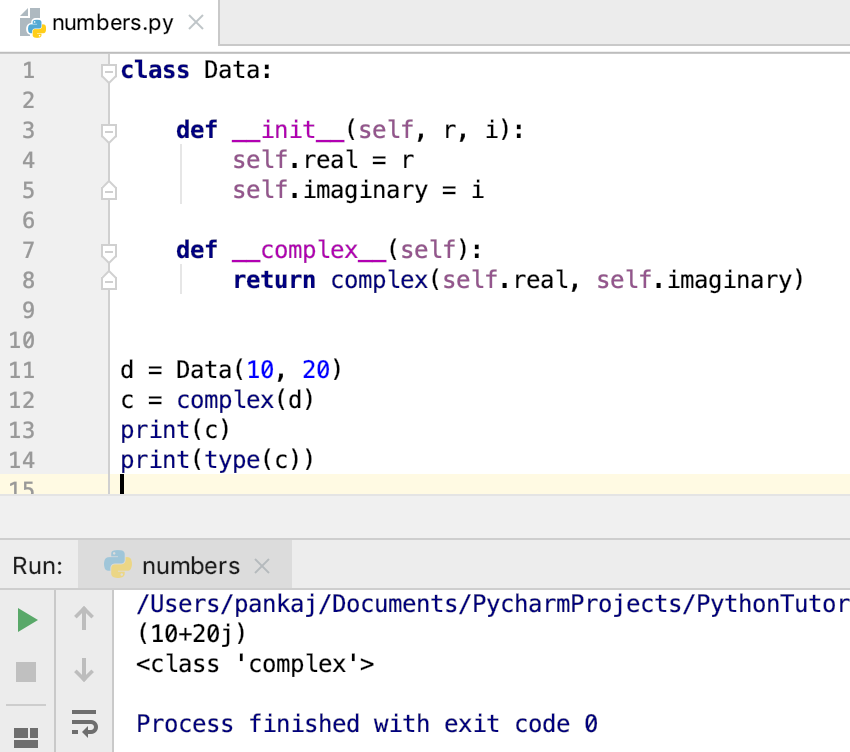Классы, объекты и методы в python
Содержание:
- Источники
- post-init parameters
- Определение конструктора для класса
- Увеличение объема памяти: полный успех
- Наследование
- Возвращает тип объекта и является собственным метаклассом языка Python.
- 9.6. Private Variables¶
- Наследование и полиморфизм
- 9.4. Random Remarks¶
- «Приватные» поля класса
- 4.2. for Statements¶
- 4.8. Intermezzo: Coding Style¶
- Дескрипторы данных в классе (дескрипторы атрибутов).
- Атрибут __dict__
- Пример дескриптора класса.
- 8.7. Class definitions¶
- Методы и функции
- 8.8. Coroutines¶
- Python Tutorial
- «Голое» исключение
- Увлечения и хобби – есть ли разница
- Протокол дескрипторов класса.
Источники
post-init parameters
In an earlier version of this PEP before InitVar was added, the
post-init function __post_init__ never took any parameters.
The normal way of doing parameterized initialization (and not just
with Data Classes) is to provide an alternate classmethod constructor.
For example:
@dataclass
class C:
x: int
@classmethod
def from_file(cls, filename):
with open(filename) as fl:
file_value = int(fl.read())
return C(file_value)
c = C.from_file('file.txt')
Because the __post_init__ function is the last thing called in the
generated __init__, having a classmethod constructor (which can
also execute code immediately after constructing the object) is
functionally equivalent to being able to pass parameters to a
__post_init__ function.
With InitVars, __post_init__ functions can now take
parameters. They are passed first to __init__ which passes them
to __post_init__ where user code can use them as needed.
The only real difference between alternate classmethod constructors
and InitVar pseudo-fields is in regards to required non-field
parameters during object creation. With InitVars, using
__init__ and the module-level replace() function InitVars
must always be specified. Consider the case where a context
object is needed to create an instance, but isn’t stored as a field.
With alternate classmethod constructors the context parameter is
always optional, because you could still create the object by going
through __init__ (unless you suppress its creation). Which
approach is more appropriate will be application-specific, but both
approaches are supported.
Определение конструктора для класса
Если вы заметили реализацию класса Employee, невозможно установить значение employee_id. Мы можем определить отдельный метод для установки значения employee_id. Но это обязательное свойство объекта Employee. Лучшее место для установки этих свойств — через конструктор.
Давайте продолжим и создадим конструктор для класса Employee. Мы ожидаем, что вызывающая программа передаст значение employee_id в качестве аргумента.
class Employee:
def __init__(self, i):
self.employee_id = i
def work(self):
print(f'{self.employee_id} is working')
emp = Employee(100)
emp.work()
Выход:
Примечание: предыдущий код для создания объекта Employee теперь не будет работать, потому что конструктор Employee ожидает аргумент. Если мы вызовем , он вызовет ошибку TypeError: в init() отсутствует 1 обязательный позиционный аргумент: ‘id’.
Можем ли мы иметь несколько конструкторов?
В отличие от других популярных объектно-ориентированных языков программирования, Python не поддерживает перегрузку методов и конструкторов.
Однако, если мы определим несколько конструкторов в классе, это не вызовет никаких ошибок. Последний конструктор перезапишет ранее определенное определение конструктора. Давайте посмотрим на это на примере.
class Employee:
def __init__(self, id):
self.employee_id = id
# this will overwrite earlier defined constructor
def __init__(self, id, n):
self.employee_id = id
self.emp_name = n
def work(self):
print(f'{self.emp_name} is working')
emp = Employee(100, 'Pankaj')
emp.work()
emp = Employee(100) # will raise Error
emp.work()
Вывод:
Pankaj is working
Traceback (most recent call last):
File "/Users/pankaj/Documents/PycharmProjects/AskPython/hello-world/class_examples.py", line 19, in <module>
emp = Employee(100)
TypeError: __init__() missing 1 required positional argument: 'n'
Увеличение объема памяти: полный успех
Наследование
поддерживают наследование так же как обычные классы Python.
Таким образом, атрибуты, определенные в родительском классе, будут доступны и в дочернем классе.
@dataclass
class Person:
age: int = 0
name: str
@dataclass
class Student(Person):
grade: int
>>> s = Student(20, "John Doe", 12)
>>> s.age
>>> 20
>>> s.name
>>> "John Doe"
>>> s.grade
>>> 12
Обратите внимание на тот факт, что аргументы для Student находятся в порядке полей, определенных в определении класса. Как себя ведет __post_init__ во время наследования?
Как себя ведет __post_init__ во время наследования?
Поскольку __post_init__ — это просто еще одна функция, ее вызов не меняется:
@dataclass
class A:
a: int
def __post_init__(self):
print("A")
@dataclass
class B(A):
b: int
def __post_init__(self):
print("B")
>>> a = B(1,2)
>>> B
В приведенном выше примере вызывается только метод __post_init__ класса B. Но как нам вызвать метод __post_init__ класса A?
Поскольку это функция родительского класса, его можно вызвать с помощью super.
@dataclass
class B(A):
b: int
def __post_init__(self):
super().__post_init__() #Call post init of A
print("B")
>>> a = B(1,2)
>>> A
B
Возвращает тип объекта и является собственным метаклассом языка Python.
Параметры:
- — объект, тип которого определяется
- — имя для создаваемого типа
- — кортеж с родительскими классами
- — словарь, будет являться пространством имён для тела класса
Возвращаемое значение:
- тип объекта, при ,
- объект нового типа при .
Вызов класса с одним аргументом:
Класс с одним аргументом возвращает тип объекта. Возвращаемое значение — это как правило, тот же объект, что и возвращаемый .
Рекомендуется для проверки типа объекта использовать встроенную функцию , так как она принимает во внимание подклассы
Примеры использования класса при вызове с одним аргументом.
>>> x = 1 >>> type(x) # <class 'int'> >>> x = 1, 2, 3 >>> type(x) # <class 'list'> # проверка типа объекта >>> x = 1 >>> isinstance(x, int) # True >>> x = 1, 2, 3 >>> isinstance(x, list) # True
Вызов класса с тремя аргументами:
Класс с тремя аргументами вернет объект нового типа. Это по сути динамическая форма инструкции , ее еще называют метакласс.
Другими словами класс , вызванный с тремя аргументами на самом деле ! Класс это метакласс, который Python внутренне использует для создания всех классов.
Все, с чем имеем дело в Python, является объектом. Сюда входят функции и классы целые числа, строки и т.д. Все они объекты. И все они созданы из класса.
# type - это тип всех типов, для # которых не указан явно иной метакласс >>> type(type) # <class 'type'> >>> type(object) # <class 'type'> >>> type(list) # <class 'type'> >>> type(int) # <class 'type'> >>> class Bar(object): pass >>> type(Bar) # <class 'type'>
В общем — это класс всех классов в языке Python и является собственным метаклассом. Класс нельзя воспроизвести на чистом Python.
Аргумент является именем класса и становится атрибутом . это кортеж, в котором перечисляются базовые классы, он становится атрибутом . — это пространство имен, содержащее определения для тела класса, которое копируется в стандартный словарь и становится атрибутом .
Понятия класс и тип по сути являются синонимами. Пользовательские типы данных могут быть сконструированы налету, во время исполнения, при помощи вызова с тремя аргументами или определены в коде, например при помощи инструкции .
Важно понимать, что тип, как и другие сущности в Python, тоже является объектом. Изменено в Python 3.6: подклассы, которые не переопределяют, больше не могут использовать форму с одним аргументом для получения типа объекта
Изменено в Python 3.6: подклассы, которые не переопределяют, больше не могут использовать форму с одним аргументом для получения типа объекта.
9.6. Private Variables¶
“Private” instance variables that cannot be accessed except from inside an
object don’t exist in Python. However, there is a convention that is followed
by most Python code: a name prefixed with an underscore (e.g. ) should
be treated as a non-public part of the API (whether it is a function, a method
or a data member). It should be considered an implementation detail and subject
to change without notice.
Since there is a valid use-case for class-private members (namely to avoid name
clashes of names with names defined by subclasses), there is limited support for
such a mechanism, called name mangling. Any identifier of the form
(at least two leading underscores, at most one trailing underscore)
is textually replaced with , where is the
current class name with leading underscore(s) stripped. This mangling is done
without regard to the syntactic position of the identifier, as long as it
occurs within the definition of a class.
Name mangling is helpful for letting subclasses override methods without
breaking intraclass method calls. For example:
class Mapping
def __init__(self, iterable):
self.items_list = []
self.__update(iterable)
def update(self, iterable):
for item in iterable
self.items_list.append(item)
__update = update # private copy of original update() method
class MappingSubclass(Mapping):
def update(self, keys, values):
# provides new signature for update()
# but does not break __init__()
for item in zip(keys, values):
self.items_list.append(item)
The above example would work even if were to introduce a
identifier since it is replaced with in the
class and in the
class respectively.
Note that the mangling rules are designed mostly to avoid accidents; it still is
possible to access or modify a variable that is considered private. This can
even be useful in special circumstances, such as in the debugger.
Наследование и полиморфизм
Наследование и полиморфизм – две фундаментальные концепции в ООП. Благодаря первому, объекты получают (другими словами, наследуют) атрибуты и функциональные возможности других объектов, создавая иерархию от более общих объектов к более конкретным. Например, и класс Car (машина), и класс Boat (лодка) являются конкретными типами класса Vehicle (транспортное средство). Оба объекта наследуют поведение одного родительского объекта или множества родительских объектов. В этом случае их называют дочерними объектами.
Полиморфизм, в свою очередь, — это возможность работы с разными объектами с помощью одной и той же функции или метода.
Обе эти фундаментальные ООП-концепции реализованы в Java и Python совершенно по-разному.
9.4. Random Remarks¶
If the same attribute name occurs in both an instance and in a class,
then attribute lookup prioritizes the instance:
>>> class Warehouse
purpose = 'storage'
region = 'west'
>>> w1 = Warehouse()
>>> print(w1.purpose, w1.region)
storage west
>>> w2 = Warehouse()
>>> w2.region = 'east'
>>> print(w2.purpose, w2.region)
storage east
Data attributes may be referenced by methods as well as by ordinary users
(“clients”) of an object. In other words, classes are not usable to implement
pure abstract data types. In fact, nothing in Python makes it possible to
enforce data hiding — it is all based upon convention. (On the other hand,
the Python implementation, written in C, can completely hide implementation
details and control access to an object if necessary; this can be used by
extensions to Python written in C.)
Clients should use data attributes with care — clients may mess up invariants
maintained by the methods by stamping on their data attributes. Note that
clients may add data attributes of their own to an instance object without
affecting the validity of the methods, as long as name conflicts are avoided —
again, a naming convention can save a lot of headaches here.
There is no shorthand for referencing data attributes (or other methods!) from
within methods. I find that this actually increases the readability of methods:
there is no chance of confusing local variables and instance variables when
glancing through a method.
Often, the first argument of a method is called . This is nothing more
than a convention: the name has absolutely no special meaning to
Python. Note, however, that by not following the convention your code may be
less readable to other Python programmers, and it is also conceivable that a
class browser program might be written that relies upon such a convention.
Any function object that is a class attribute defines a method for instances of
that class. It is not necessary that the function definition is textually
enclosed in the class definition: assigning a function object to a local
variable in the class is also ok. For example:
# Function defined outside the class
def f1(self, x, y):
return min(x, x+y)
class C
f = f1
def g(self):
return 'hello world'
h = g
Now , and are all attributes of class that refer to
function objects, and consequently they are all methods of instances of
— being exactly equivalent to . Note that this practice
usually only serves to confuse the reader of a program.
Methods may call other methods by using method attributes of the
argument:
class Bag
def __init__(self):
self.data = []
def add(self, x):
self.data.append(x)
def addtwice(self, x):
self.add(x)
self.add(x)
Methods may reference global names in the same way as ordinary functions. The
global scope associated with a method is the module containing its
definition. (A class is never used as a global scope.) While one
rarely encounters a good reason for using global data in a method, there are
many legitimate uses of the global scope: for one thing, functions and modules
imported into the global scope can be used by methods, as well as functions and
classes defined in it. Usually, the class containing the method is itself
defined in this global scope, and in the next section we’ll find some good
reasons why a method would want to reference its own class.
«Приватные» поля класса
Вы обратили внимание, что в нашем классе некоторые атрибуты начинаются с нижнего подчеркивания? Это одно из множества соглашений принятых в сообществе разработчиков на языке Python, согласно которому «приватные» атрибуты должны начинаться с одного символа нижнего подчеркивания. Давайте создадим нового пользователя:. Допустим, что мы хотим изменить пароль (или адрес электронной почты) и делаем это через прямое обращение к атрибуту:
Допустим, что мы хотим изменить пароль (или адрес электронной почты) и делаем это через прямое обращение к атрибуту:
Почему пароль не прошел проверку? Мы изменили значение атрибута напрямую, не используя функцию , таким образом, мы сохранили пароль в открытом виде. В свою очередь функция хеширует переданный ей пароль в качестве аргумента и затем сравнивает его с паролем, который хранился в атрибуте .
Note
Больше про нижние подчеркивания можно узнать тут.
4.2. for Statements¶
The statement in Python differs a bit from what you may be used
to in C or Pascal. Rather than always iterating over an arithmetic progression
of numbers (like in Pascal), or giving the user the ability to define both the
iteration step and halting condition (as C), Python’s statement
iterates over the items of any sequence (a list or a string), in the order that
they appear in the sequence. For example (no pun intended):
>>> # Measure some strings: ... words = 'cat', 'window', 'defenestrate' >>> for w in words ... print(w, len(w)) ... cat 3 window 6 defenestrate 12
Code that modifies a collection while iterating over that same collection can
be tricky to get right. Instead, it is usually more straight-forward to loop
over a copy of the collection or to create a new collection:
4.8. Intermezzo: Coding Style¶
Now that you are about to write longer, more complex pieces of Python, it is a
good time to talk about coding style. Most languages can be written (or more
concise, formatted) in different styles; some are more readable than others.
Making it easy for others to read your code is always a good idea, and adopting
a nice coding style helps tremendously for that.
For Python, PEP 8 has emerged as the style guide that most projects adhere to;
it promotes a very readable and eye-pleasing coding style. Every Python
developer should read it at some point; here are the most important points
extracted for you:
-
Use 4-space indentation, and no tabs.
4 spaces are a good compromise between small indentation (allows greater
nesting depth) and large indentation (easier to read). Tabs introduce
confusion, and are best left out. -
Wrap lines so that they don’t exceed 79 characters.
This helps users with small displays and makes it possible to have several
code files side-by-side on larger displays. -
Use blank lines to separate functions and classes, and larger blocks of
code inside functions. -
When possible, put comments on a line of their own.
-
Use docstrings.
-
Use spaces around operators and after commas, but not directly inside
bracketing constructs: . -
Name your classes and functions consistently; the convention is to use
for classes and for functions
and methods. Always use as the name for the first method argument
(see for more on classes and methods). -
Don’t use fancy encodings if your code is meant to be used in international
environments. Python’s default, UTF-8, or even plain ASCII work best in any
case. -
Likewise, don’t use non-ASCII characters in identifiers if there is only the
slightest chance people speaking a different language will read or maintain
the code.
Footnotes
-
Actually, call by object reference would be a better description,
since if a mutable object is passed, the caller will see any changes the
callee makes to it (items inserted into a list).
Дескрипторы данных в классе (дескрипторы атрибутов).
Вызов функции — это краткий способ построения дескриптора данных, который запускает вызовы функций при доступе к атрибуту.
Его подпись:
property(fget=None, fset=None, fdel=None, doc=None) -> property attribute
В документации показано типичное использование для определения управляемого атрибута :
class C
def getx(self): return self.__x
def setx(self, value): self.__x = value
def delx(self): del self.__x
x = property(getx, setx, delx, "I'm the 'x' property.")
Чтобы увидеть, как функция реализована с точки зрения , вот чистый эквивалент на Python:
class Property
"Emulate PyProperty_Type() in Objects/descrobject.c"
def __init__(self, fget=None, fset=None, fdel=None, doc=None):
self.fget = fget
self.fset = fset
self.fdel = fdel
if doc is None and fget is not None
doc = fget.__doc__
self.__doc__ = doc
def __get__(self, obj, objtype=None):
if obj is None
return self
if self.fget is None
raise AttributeError("unreadable attribute")
return self.fget(obj)
def __set__(self, obj, value):
if self.fset is None
raise AttributeError("can't set attribute")
self.fset(obj, value)
def __delete__(self, obj):
if self.fdel is None
raise AttributeError("can't delete attribute")
self.fdel(obj)
def getter(self, fget):
return type(self)(fget, self.fset, self.fdel, self.__doc__)
def setter(self, fset):
return type(self)(self.fget, fset, self.fdel, self.__doc__)
def deleter(self, fdel):
return type(self)(self.fget, self.fset, fdel, self.__doc__)
Встроенная функция помогает всякий раз, когда пользовательский интерфейс предоставляет доступ к атрибутам, а затем последующие изменения требуют вмешательства метода.
Например, класс электронных таблиц может предоставлять доступ к значению ячейки через . Последующие усовершенствования программы требуют, чтобы ячейка пересчитывалась при каждом доступе, но программист не хочет влиять на существующий клиентский код, напрямую обращающийся к атрибуту. Решение состоит в том, чтобы обернуть доступ к атрибуту в дескриптор данных свойства:
class Cell
. . .
def getvalue(self):
"Recalculate the cell before returning value"
self.recalc()
return self._value
value = property(getvalue)
Классно, неправда ли?
Атрибут __dict__
В Python у объектов есть встроенные специальные атрибуты. Мы их не определяем, но они есть. Одним из таких атрибутов объекта является свойство __dict__. Его значением является словарь, в котором ключи – это имена свойств экземпляра, а значения – текущие значения свойств.
>>> class B:
... n = 5
... def adder(self, v):
... return v + self.n
...
>>> w = B()
>>> w.__dict__
{}
>>> w.n = 8
>>> w.__dict__
{'n': 8}
В примере у экземпляра класса B сначала нет собственных атрибутов. Свойство и метод – это атрибуты объекта-класса, а не объекта-экземпляра, созданного от этого класса. Лишь когда мы выполняем присваивание новому полю экземпляра, у него появляется собственное свойство, что мы наблюдаем через словарь __dict__.
В следующем уроке мы увидим, что свойства экземпляра обычно не назначаются за пределами класса. Это происходит в методах классах путем присваивание через self. Например, .
Атрибут __dict__ используется для просмотра всех текущих свойств объекта. С его помощью можно удалять, добавлять свойства, а также изменять их значения.
>>> w.__dict__ = 100
>>> w.__dict__
{'n': 8, 'm': 100}
>>> w.m
100
Пример дескриптора класса.
Следующий код создает класс, объектами которого являются дескрипторы данных, которые печатают сообщение для каждого или . Переопределение — это альтернативный подход, который может сделать это для каждого атрибута. Однако этот дескриптор полезен для мониторинга только нескольких выбранных атрибутов:
class RevealAccess
"""Дескриптор данных, который обычно устанавливает и возвращает
значения и печатает сообщение, регистрирующее их доступ.
"""
def __init__(self, initval=None, name='var'):
self.val = initval
self.name = name
def __get__(self, obj, objtype):
print('Retrieving', self.name)
return self.val
def __set__(self, obj, val):
print('Updating', self.name)
self.val = val
>>> class MyClass
... x = RevealAccess(10, 'var "x"')
... y = 5
...
>>> m = MyClass()
>>> m.x
# Retrieving var "x"
# 10
>>> m.x = 20
# Updating var "x"
>>> m.x
# Retrieving var "x"
# 20
>>> m.y
# 5
Протокол дескрипторов класса очень прост и предлагает огромные возможности. Некоторые варианты использования настолько распространены, что были объединены в отдельные вызовы функций. Свойства, связанные методы, статические методы и методы классов основаны на протоколе дескриптора!
8.7. Class definitions¶
A class definition defines a class object (see section ):
classdef ::= [] "class" [] ":"
inheritance ::= "(" [] ")"
classname ::=
A class definition is an executable statement. The inheritance list usually
gives a list of base classes (see for more advanced uses), so
each item in the list should evaluate to a class object which allows
subclassing. Classes without an inheritance list inherit, by default, from the
base class ; hence,
class Foo
pass
is equivalent to
class Foo(object):
pass
The class’s suite is then executed in a new execution frame (see ),
using a newly created local namespace and the original global namespace.
(Usually, the suite contains mostly function definitions.) When the class’s
suite finishes execution, its execution frame is discarded but its local
namespace is saved. A class object is then created using the inheritance
list for the base classes and the saved local namespace for the attribute
dictionary. The class name is bound to this class object in the original local
namespace.
The order in which attributes are defined in the class body is preserved
in the new class’s . Note that this is reliable only right
after the class is created and only for classes that were defined using
the definition syntax.
Class creation can be customized heavily using .
Classes can also be decorated: just like when decorating functions,
@f1(arg) @f2 class Foo pass
is roughly equivalent to
class Foo pass Foo = f1(arg)(f2(Foo))
The evaluation rules for the decorator expressions are the same as for function
decorators. The result is then bound to the class name.
Changed in version 3.9: Classes may be decorated with any valid .
Previously, the grammar was much more restrictive; see PEP 614 for
details.
Programmer’s note: Variables defined in the class definition are class
attributes; they are shared by instances. Instance attributes can be set in a
method with . Both class and instance attributes are
accessible through the notation “”, and an instance attribute hides
a class attribute with the same name when accessed in this way. Class
attributes can be used as defaults for instance attributes, but using mutable
values there can lead to unexpected results.
can be used to create instance variables with different implementation details.
Методы и функции
Разница между рассматриваемыми языками заключается в том, что в Python есть функции, а в Java их нет.
В Python следующий код отработает без проблем (и используется повсеместно):
Мы можем вызвать say_hi() из любого места видимости. Эта функция не содержит ссылки на self, что означает, что это глобальная функция, а не функция класса. Она не сможет изменять или сохранять какие-нибудь данные какого-либо класса, но может использовать локальные и глобальные переменные.
В противоположность, каждая написанная нами строчка на Java принадлежит какому-нибудь классу. Функции не существует за пределами класса, и по определению все Java-функции — это методы. На Java ближе всего к чистой функции находится статичный метод:
Utils. SayHi() вызывается из любого места без предварительного создания экземпляра класса Utils. Поскольку мы вызываем SayHi() без создания объекта, ссылки this не существует. Однако, это всё равно не функция в том смысле, в котором является say_hi() в Python.
8.8. Coroutines¶
New in version 3.5.
8.8.1. Coroutine function definition
async_funcdef ::= [] "async" "def" "(" [] ")"
":"
Execution of Python coroutines can be suspended and resumed at many points
(see ). Inside the body of a coroutine function, and
identifiers become reserved keywords; expressions,
and can only be used in
coroutine function bodies.
Functions defined with syntax are always coroutine functions,
even if they do not contain or keywords.
It is a to use a expression inside the body
of a coroutine function.
An example of a coroutine function:
async def func(param1, param2):
do_stuff()
await some_coroutine()
8.8.2. The statement
async_for_stmt ::= "async"
An is able to call asynchronous code in its
iter implementation, and can call asynchronous
code in its next method.
The statement allows convenient iteration over asynchronous
iterators.
The following code:
async for TARGET in ITER
SUITE
else
SUITE2
Is semantically equivalent to:
iter = (ITER)
iter = type(iter).__aiter__(iter)
running = True
while running
try
TARGET = await type(iter).__anext__(iter)
except StopAsyncIteration
running = False
else
SUITE
else
SUITE2
See also and for details.
It is a to use an statement outside the
body of a coroutine function.
8.8.3. The statement
async_with_stmt ::= "async"
An is a that is
able to suspend execution in its enter and exit methods.
The following code:
async with EXPRESSION as TARGET
SUITE
is semantically equivalent to:
manager = (EXPRESSION)
aenter = type(manager).__aenter__
aexit = type(manager).__aexit__
value = await aenter(manager)
hit_except = False
try
TARGET = value
SUITE
except
hit_except = True
if not await aexit(manager, *sys.exc_info()):
raise
finally
if not hit_except
await aexit(manager, None, None, None)
See also and for details.
It is a to use an statement outside the
body of a coroutine function.
See also
- PEP 492 — Coroutines with async and await syntax
-
The proposal that made coroutines a proper standalone concept in Python,
and added supporting syntax.
Footnotes
-
The exception is propagated to the invocation stack unless
there is a clause which happens to raise another
exception. That new exception causes the old one to be lost. -
A string literal appearing as the first statement in the function body is
transformed into the function’s attribute and therefore the
function’s . -
A string literal appearing as the first statement in the class body is
transformed into the namespace’s item and therefore the class’s
.
Python Tutorial
Python HOMEPython IntroPython Get StartedPython SyntaxPython CommentsPython Variables
Python Variables
Variable Names
Assign Multiple Values
Output Variables
Global Variables
Variable Exercises
Python Data TypesPython NumbersPython CastingPython Strings
Python Strings
Slicing Strings
Modify Strings
Concatenate Strings
Format Strings
Escape Characters
String Methods
String Exercises
Python BooleansPython OperatorsPython Lists
Python Lists
Access List Items
Change List Items
Add List Items
Remove List Items
Loop Lists
List Comprehension
Sort Lists
Copy Lists
Join Lists
List Methods
List Exercises
Python Tuples
Python Tuples
Access Tuples
Update Tuples
Unpack Tuples
Loop Tuples
Join Tuples
Tuple Methods
Tuple Exercises
Python Sets
Python Sets
Access Set Items
Add Set Items
Remove Set Items
Loop Sets
Join Sets
Set Methods
Set Exercises
Python Dictionaries
Python Dictionaries
Access Items
Change Items
Add Items
Remove Items
Loop Dictionaries
Copy Dictionaries
Nested Dictionaries
Dictionary Methods
Dictionary Exercise
Python If…ElsePython While LoopsPython For LoopsPython FunctionsPython LambdaPython ArraysPython Classes/ObjectsPython InheritancePython IteratorsPython ScopePython ModulesPython DatesPython MathPython JSONPython RegExPython PIPPython Try…ExceptPython User InputPython String Formatting
«Голое» исключение
Есть еще один способ поймать ошибку:
Python
try:
1 / 0
except:
print(«You cannot divide by zero!»)
|
1 |
try 1 except print(«You cannot divide by zero!») |
Но мы его не рекомендуем. На жаргоне Пайтона, это известно как голое исключение, что означает, что будут найдены вообще все исключения. Причина, по которой так делать не рекомендуется, заключается в том, что вы не узнаете, что именно за исключение вы выловите. Когда у вас возникло что-то в духе ZeroDivisionError, вы хотите выявить фрагмент, в котором происходит деление на ноль. В коде, написанном выше, вы не можете указать, что именно вам нужно выявить. Давайте взглянем еще на несколько примеров:
Python
my_dict = {«a»:1, «b»:2, «c»:3}
try:
value = my_dict
except KeyError:
print(«That key does not exist!»)
|
1 |
my_dict={«a»1,»b»2,»c»3} try value=my_dict»d» exceptKeyError print(«That key does not exist!») |
Python
my_list =
try:
my_list
except IndexError:
print(«That index is not in the list!»)
|
1 |
my_list=1,2,3,4,5 try my_list6 exceptIndexError print(«That index is not in the list!») |
В первом примере, мы создали словарь из трех элементов. После этого, мы попытались открыть доступ ключу, которого в словаре нет. Так как ключ не в словаре, возникает KeyError, которую мы выявили. Второй пример показывает список, длина которого состоит из пяти объектов. Мы попытались взять седьмой объект из индекса.
Помните, что списки в Пайтоне начинаются с нуля, так что когда вы говорите 6, вы запрашиваете 7. В любом случае, в нашем списке только пять объектов, по этой причине возникает IndexError, которую мы выявили. Вы также можете выявить несколько ошибок за раз при помощи одного оператора. Для этого существует несколько различных способов. Давайте посмотрим:
Python
my_dict = {«a»:1, «b»:2, «c»:3}
try:
value = my_dict
except IndexError:
print(«This index does not exist!»)
except KeyError:
print(«This key is not in the dictionary!»)
except:
print(«Some other error occurred!»)
|
1 |
my_dict={«a»1,»b»2,»c»3} try value=my_dict»d» exceptIndexError print(«This index does not exist!») exceptKeyError print(«This key is not in the dictionary!») except print(«Some other error occurred!») |
Это самый стандартный способ выявить несколько исключений. Сначала мы попробовали открыть доступ к несуществующему ключу, которого нет в нашем словаре. При помощи try/except мы проверили код на наличие ошибки KeyError, которая находится во втором операторе except
Обратите внимание на то, что в конце кода у нас появилась «голое» исключение. Обычно, это не рекомендуется, но вы, возможно, будете сталкиваться с этим время от времени, так что лучше быть проинформированным об этом
Кстати, также обратите внимание на то, что вам не нужно использовать целый блок кода для обработки нескольких исключений. Обычно, целый блок используется для выявления одного единственного исключения. Изучим второй способ выявления нескольких исключений:
Python
try:
value = my_dict
except (IndexError, KeyError):
print(«An IndexError or KeyError occurred!»)
|
1 |
try value=my_dict»d» except(IndexError,KeyError) print(«An IndexError or KeyError occurred!») |
Обратите внимание на то, что в данном примере мы помещаем ошибки, которые мы хотим выявить, внутри круглых скобок. Проблема данного метода в том, что трудно сказать какая именно ошибка произошла, так что предыдущий пример, мы рекомендуем больше чем этот
Зачастую, когда происходит ошибка, вам нужно уведомить пользователя, при помощи сообщения.
В зависимости от сложности данной ошибки, вам может понадобиться выйти из программы. Иногда вам может понадобиться выполнить очистку, перед выходом из программы. Например, если вы открыли соединение с базой данных, вам нужно будет закрыть его, перед выходом из программы, или вы можете закончить с открытым соединением. Другой пример – закрытие дескриптора файла, к которому вы обращаетесь. Теперь нам нужно научиться убирать за собой. Это очень просто, если использовать оператор finally.
Увлечения и хобби – есть ли разница
Мнения людей о том, есть ли разница между понятиями хобби и увлечения во многом расходятся. Причина в том, что одни опираются исключительно на перевод иностранного слова, а другие вкладывают в понятия более глубокий смысл.
В переводе с английского hobby – увлечение, деятельность, которой занимаются для удовольствия в свободное время. Если ограничиваться только дословным переводом, то разницы между увлечением и хобби нет, а эти слова – обычные синонимы. Но русский язык богаче и глубже.
К хобби принято относить занятия, которыми человек занимается регулярно, постоянно совершенствуя свои навыки и расширяя границы. Увлеченные женщины и мужчины развиваются в любимом направлении, изучают новые техники, покупают дополнительное оборудование, чтобы двигаться дальше.
Увлечениями часто называют направления, которые привлекают человека, но в силу обстоятельств он пока не углубился в этот вид деятельности. Например, женщине нравится шить и вязать, но она занимается этим лишь изредка, потому что нет времени или настроения развиваться дальше.
Хобби – это когда не просто нравится наблюдать и интересно изучать, это активное участие и развитие в выбранном ключе. Одно дело, если нравится вышивать крестиком на больничном, а другое, когда потребность в вышивке ежедневная, а стремление достичь мастерства растет с каждым новым успехом.
Протокол дескрипторов класса.
descr.__get__(self, obj, type=None) -> value descr.__set__(self, obj, value) -> None descr.__delete__(self, obj) -> None
Вот и все, что нужно сделать. Определите любой из этих методов и объект будет считаться дескриптором и может переопределить поведение по умолчанию при поиске в качестве атрибута.
Если объект определяет или , то он считается дескриптором данных. Дескрипторы, которые определяют только , называются дескрипторами без данных, обычно они используются для методов, но возможны и другие применения.
Дескрипторы данных и дескрипторы без данных различаются тем, как вычисляются переопределения по отношению к записям в словаре экземпляра. Если словарь экземпляра содержит запись с тем же именем, что и дескриптор данных, то дескриптор данных имеет приоритет. Если словарь экземпляра содержит запись с тем же именем, что и дескриптор без данных, то уже запись будет имеет приоритет.
Чтобы создать дескриптор данных только для чтения, определите как , так и с методом , вызывающим исключение при вызове. Определение метода с , достаточно, чтобы сделать его дескриптором данных.








